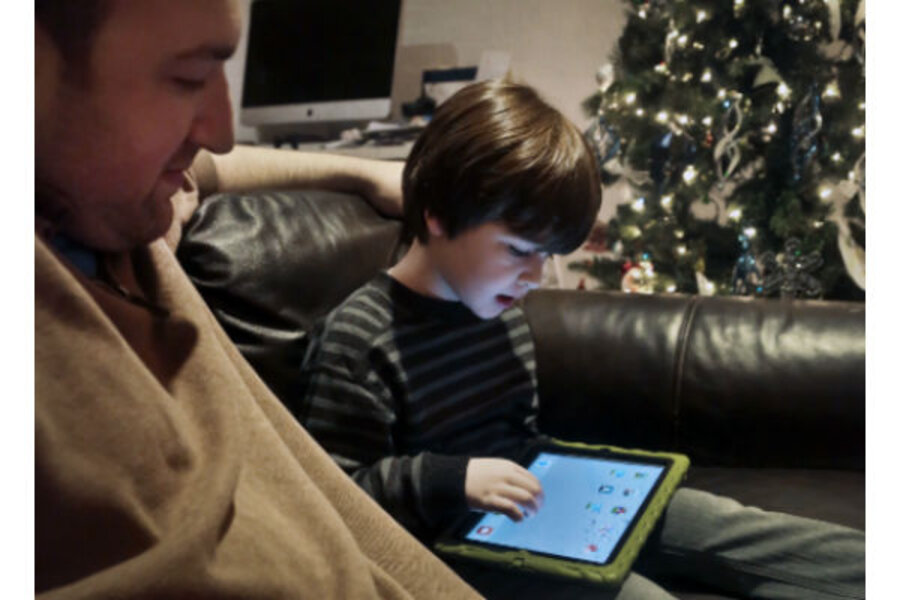Kids and technology: Three household principles
Loading...
Holiday shopping for young children includes a host of “educational” options. As a well-intentioned parent, my first impulse is to think that these toys are better than others because educational is always better than non-educational, right? Device and app marketing can be the most convincing.
Yet, why do we think phones and tablets will make young children smarter automatically if the games come from the “educational” section? Because app developers told us so?
At the Costco, the gas station, the doctor’s office, the coffee shop, and [sigh] even my own house, I see children on their electronic devices having little interaction with peers or adults. Sometimes they look up, excitedly shout that they made it to a new level and then go back to the intense concentration some call learning.
A recent TV report showed young children in poverty-stricken areas of West Africa using tablets to learn how to read. Children held tablets in their arms like teddy bears and smiled to the camera. One young girl alone on a bench stared intently at a phone, giggling to herself. The tech company executive said that tablet applications were key to improving education in places that don’t have enough teachers “like Africa.”
What 5-year-old child with a tablet is going to get herself out of poverty?
As a professor of early childhood education, I know that children learn and grow in many different ways. Too often, tablets, phones, and apps distract rather than support the types of educational experiences young children need most.
It seems that even CEOs of major tech companies and Steve Jobs himself saw technology as potentially harmful for young children.
Technology can be a part of that process, but not without people being involved and creating a creative and social experience with the technology. The problem is that so many children using iPhone or tablets are doing so alone without any kind of social engagement afterwards. In the report on tablets and education in Africa, there were no adults in any of the pictures as if saying the technology made them unnecessary or replaced them.
Selling the idea that technology alone is the key to educating young children or changing the academic trajectory of a young child (whether they are in New York City or Accra) seems dangerous to me. Especially when companies stand to make money by selling technology as the way to overcome educational problems in poor nations, as the report seemed to be implying.
It also seems as though we might be exporting a problem we have not solved in our own homes. Should we rely on tablets and the current range of apps to help young children learn?
The Pew Research Internet Project estimates that more than 50 percent of parents in the US own tablet computers. I often hear parents saying in disbelief but also proudly that their toddler can use the iPad by themselves with no help. But just because they can doesn’t mean they should.
Young children need more than phones and tablets to learn. Young children learn best when there is stability, relationships, sustained dynamic learning opportunities, and positive environments that support healthy identity formation. So far, apps have mostly created isolated children, rather than experimentation, discovery, or socially engaged learning experiences. We need more apps that foster collective creativity and social experiences with young children, particularly for classrooms. There are only a few apps that allow young children to conduct research, pursue interests, or work collaboratively. Too many just act like electronic worksheets with points and cute graphics.
Despite my confidence about how young children learn, I get caught up sometimes in the promise of new technology with my eleven, nine, and four-year -olds. I want my kids to see themselves as prosumers of technology. But I don’t want the electronics to isolate them from one another. So we usually have three operating principles when it comes to using and purchasing apps and devices.
1. Electronics are always used with a sibling, friend, or in a social space, never completely alone.
2. Apps that are purchased should mostly be those that ignite curiosity or allow kids (even young kids) to do research.
3. Electronics have to take a rest if relationships are suffering.
Devices and apps are educational when young kids can be creative with them and apply what they are learn to objects and situations in their real lives. We try to keep anything that is not really educational but super fun rooted in the physical world and face-to-face interaction, especially while they are young and learning what it means to be a learner and participate socially.
Still, it is clear that technology is important, even critical for children around the world. The lack of both technology and teachers who are well trained to incorporate technology in innovative, engaging, dynamic curriculum have continued the digital divide between rich and poor in many countries.
Technology should encourage and even require creative manipulation and social engagement. Just because a device or app is labeled as “educational” doesn’t make it so. Toys that prompt lots of creativity and social, in-person interaction is a much more educational option for a young child than a letter or math game app.
The Christian Science Monitor has assembled a diverse group of the best family and parenting bloggers out there. Our contributing and guest bloggers are not employed or directed by the Monitor, and the views expressed are the bloggers' own.
Jennifer Keys Adair, Ph.D., is a professor of Early Childhood Education at The University of Texas at Austin, a young scholar fellow with the Foundation for Child Development and a public voices fellow with The OpEd Project. She also is the co-author of Children Crossing Borders as well as a series of research articles on early learning in diverse classrooms, all of which can be found at jenniferkeysadair.com.







